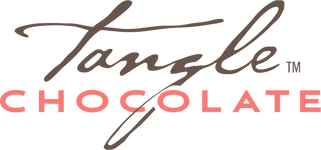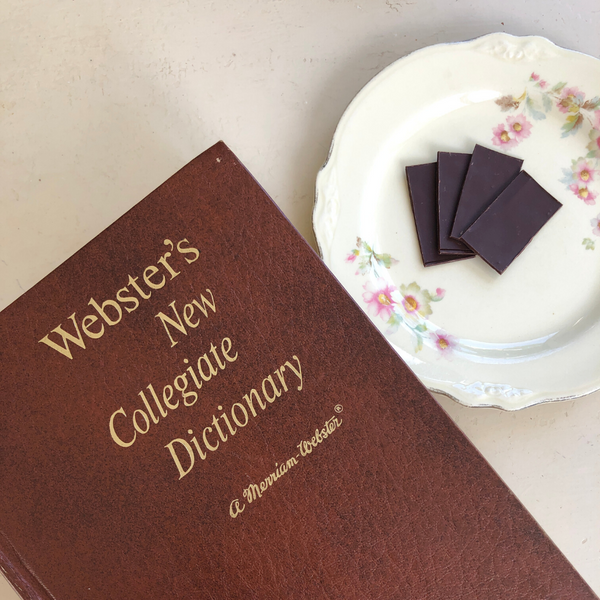DEFINING CHOCOLATE: A GLOSSARY OF CHOCOLATE TERMS
Jun 25, 2020
You don’t just want to know that you’re buying ethical, delicious chocolate––you want to be able to sound knowledgeable when you present a box of THINS to your daughter-in-law, your neighbor, your mail carrier. After giving this list of chocolate terminology a read, you’ll be ready to impress your loved ones not only with your thoughtful gift, but with your wide chocolate vocabulary (chocabulary?).
Bloom: In chocolate terms, “bloom” isn’t nearly as pretty as you might expect. “Bloom” refers to when chocolate experiences a change in temperature or humidity, which causes the cocoa butter that is naturally occurring in chocolate to separate from the cocoa mass and migrate to the surface of the chocolate. It shows up as a whitish-gray film. The chocolate can still be eaten; it hasn’t spoiled, it has just gone out of temper. But it has a different look and mouthfeel, and is missing the “snap” of chocolate that is in temper. Read the Frequently Asked Question about how to store your chocolate to learn how to prevent it from blooming.
Bean to bar: You’ve heard of “farm to table” restaurants––“bean to bar” is similar, but referring to chocolate. While there is no legal definition of this term, it generally means chocolate that is made in small batches by a small company that starts with cacao beans, does all of the roasting and refining in house, and ends with the finished chocolate. Tangle Chocolate is bean-to-bar chocolate. “Craft” and “artisan” are other words you might see on chocolate labels, and they also do not have a legal definition. In the best use, these words also refer to bean-to-bar chocolate. However, a company can call its product craft chocolate even if they don’t actually make the chocolate - they may start with couverture which they melt and mold. And without a legal definition, these words can be used by even massive chocolate companies in an attempt to make their chocolate seem like it is higher quality. (Nestle recently introduced Artisan Toll House chocolate chips, for example.)
Cacao beans, or cocoa beans: Cacao beans are not really beans at all, but rather the seeds of the tropical cacao fruit tree. They are found inside cacao pods that resemble papayas in shape and size. Cacao beans start out white in color, and are surrounded by a soft, slimy, deliciously tart pulp. They become brown during the fermentation process. Some sources say that technically the beans should be called cocoa beans once they have been roasted, but the words are used pretty much interchangeably.
Cocoa powder: Cocoa powder is what is left after cacao beans have been roasted and then had the fatty cocoa butter pressed out of them.
Chocolatier vs. chocolate maker: These terms might sound like they can be used interchangeably, but there is an important distinction. Chocolate makers make chocolate out of cacao beans and other ingredients, whereas chocolatiers make confections and candies out of existing chocolate.
Chocolate Belt: The chocolate belt refers to the first 20º north and south around the equator, made up of tropical regions where cacao trees can grow.
Couverture: Couverture chocolate is a type of chocolate with at least 35% cocoa solids and 31% cocoa butter. The high percentage of cocoa butter makes it smooth and glossy when tempered, ideal for coating candies.
Fair trade: Products that are Fair Trade have gone through the certification process to assure their consumers that they’re sourcing their ingredients in ways that promote economic empowerment, safe working environments, and environmental conservation. Tangle Chocolate goes a step further and buys our cacao beans for more than the Fair Trade standards dictate.
Percentage of cacao: This one is pretty intuitive, but very important to keep in mind when buying chocolate. Chocolate labels that say “70% cacao” mean that cacao accounts for 70% of the weight of the bar. In Tangle Chocolate's case, the other 30% is sugar.
Single origin: Another intuitive but important term. Tangle Chocolate's chocolate is single origin, meaning the cacao that goes into our chocolate is all from the Cahabon region in Guatemala. We make single origin chocolate both because we want to invest in a single community where our dollars will make the most difference, and because we like the flavor of the chocolate that comes from beans grown in this specific, unique environment.
Tempering: The final step in making chocolate in which the temperature of the melted chocolate alternates between heating and cooling, encouraging a certain type of very stable molecular crystal to be formed which results in chocolate that has a glossy appearance and makes a “snap” sound when it’s broken. Chocolate is said to be “in temper” when it exhibits these characteristics.
Terroir: You might have heard this term when it comes to wine, but it applies to chocolate as well. “Terroir” refers to all of the environmental conditions that can contribute to the flavor of cacao, such as the soil or micro-climate in which the cacao grows.
THINS: Tangle Chocolate wants to make chocolate an experience, rather than just a snack. Our chocolate comes in melt-in-your-mouth THINS, so as to best experience the luxurious flavor profile.


